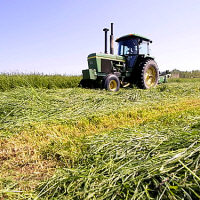



2006 Census Of Agriculture Shows Canada's Long Term Decline Continues
CANADA - Today, Statistics Canada provided the latest snapshot of the nation's agriculture industry, using new data from the 2006 Census of Agriculture. |
| Number of farms dwindles, but acreage steady |
Between 2001 and 2006, both the number of census farms in Canada and the number of farm operators continued their long-term decline.
The census counted 229,373 census farms as of May 16, 2006, down 7.1% or 17,550 from 2001. At the same time, it counted 327,060 farm operators, a 5.5% decline, the equivalent of 19,140 people.
Just over one-quarter (27.8%) of farm operators were women in 2006, up slightly from 26.3% five years earlier.
The number of farms fell in every province, and the rate of decline was fastest in Newfoundland and Labrador and Saskatchewan.
Farm numbers have been declining steadily in Canada since 1941. The decrease during the past five years was slower than the 10.7% drop between 1996 and 2001. However, the lower numbers do not tell the whole story about the capability of today's agriculture industry to adapt.
For instance, Canada's agricultural land base (the total amount of land on farms) remained virtually unchanged at just over 67.6 million hectares (167 million acres). The size of the average farm rose from 273 hectares to 295 hectares (676 acres to 728 acres).
In 2005, gross farm receipts amounted to an estimated $42.2 billion, up 8.8% from 2000 (at 2005 constant prices). This includes government program payments of $4.8 billion in 2005 (representing 11.4% of gross farm receipts), up from 6.9% of receipts in 2000, largely as an impact of bovine spongiform encephalopathy (BSE). Total operating expenses rose 0.7% at 2005 constant prices to an estimated $36.4 billion.
Over this period, the prices farmers had to pay for the inputs they purchased rose more quickly than the prices they received for the products they sold. Improved efficiency, increased program payments and higher production helped to keep the ratios between expenses and receipts stable, despite this inflationary imbalance. Operators were spending an average of 86 cents in expenses (excluding depreciation) for every dollar of receipts in 2005, about half-a-cent less then they had been in 2000.
Although Canada is becoming an increasingly urban nation, one out of every seven Canadian farms had their headquarters in one of the 33 census metropolitan areas (CMAs). This proportion remained constant during the past five years.
More "million-dollar" farms
Census data showed that Canada had 5,902 "million-dollar" farms in 2006, those with gross farm receipts of $1 million or more. This compares to 4,453 five years earlier (at 2005 constant prices).
These farms comprised a relatively small proportion of the total, but their numbers are increasing. In 2001, they accounted for only 1.8% of all farms, and 34.6% of total receipts. By 2006, they accounted for 2.6% of all farms and 39.7% of total receipts.
In 2006, hog farms accounted for only 2.6% of all farm operations in Canada, but nearly 18% of them reported gross receipts of $1 million or more, the highest proportion of any farm type. Similarly, poultry and egg operations represented 2.0% of all farm operations, but about 15% of them had receipts of $1 million or more.
On the other hand, field crops are the most common type of farm across Canada. They accounted for just under 40% of all farms in 2006, but less than 2% of them reported gross receipts of $1 million or more.
Only 14.4% of all farms had gross receipts of between $250,000 and $1 million. The majority (65.6%) of Canada's 229,373 farm operations reported gross farm receipts under $100,000, while the remaining 17.4% were in the $100,000 to $249,999 receipts category.
Many small farm operations are financially viable
Nationally, 55.8% of all farms reported gross farm receipts greater than their total operating expenses, while 44.2% did not.
While the million-dollar farms are most likely to cover their operating expenses with their receipts, some farms among the smaller classes are also able to do so.
For instance, 28.6% of farms with gross receipts of less than $25,000 reported enough farm income to cover their expenses in 2005. These were most likely to be fruit and vegetable farms, and greenhouse, nursery and floriculture operations.
In contrast, 86.0% of farms with receipts of $1 million or more reported enough farm receipts to cover their expenses.
Farms in census metropolitan areas mostly smaller operations
Census of Population data released on March 13, 2007 showed Canada is an increasingly urban nation. Just over two-thirds of Canada's population in 2006 lived in the nation's 33 CMAs.
However, the Census of Agriculture showed that agriculture is no stranger to these areas. More than 15% (35,467) of the 229,373 farms counted by the census had their headquarters in one of these metropolitan areas. This has remained constant since 2001.
Most of these farms were small operations. In fact, almost half (47.5%) of them had gross receipts of less than $25,000. However, 3.4% had receipts of $1 million or more, higher than the national level (2.6%).
Field crop farms accounted for the highest proportion of farm operations in CMAs, nearly one-third (31.2%). They were followed by the category "other animal production," which includes horse farms. They accounted for 18.8% of CMA farms. Beef farms accounted for 16.7%, fruit and vegetable farms 12.9%, and greenhouses, nurseries and floriculture (including sod), 9.4%.
Greenhouses, nurseries and floriculture rely on an urban market for sales. In 2005, they accounted for 24.4% of all gross farm receipts among farms in CMAs, compared with only 7.5% on a national level.
Organic farms are also a good fit close to consumers. In 2006, 6.8% of farms in Canada reported that they were producing uncertified, transitional or certified organic products. In CMAs, the proportion was 8.3%.
British Columbia had the largest concentration of organic farms in metropolitan areas: 30.9% of farms in the Victoria CMA report organic production, Vancouver 15.7%, and Kelowna 12.3%.
More farmers working off the farm
More farmers are working off the farm than five years ago. Nearly half (48.4%) of all farm operators reported an off-farm job or business on the 2006 Census, compared with 44.5% in 2001.
Both men and women work off the farm in significant numbers. However, in 2006, for the first time, the proportion of female operators who reported off-farm work reached one-half (50.4%). In comparison, 47.6% of men had off-farm work.
Fewer farmers were working full time on the farm. In 2006, about 46.7% of farmers reported working more than 40 hours a week on their farm operations, down from 47.7% five years earlier.
In contrast, more than one-fifth (20.2%) of farmers reported working more than 40 hours a week off the farm. This was an increase from 17.6% in 2001.
From Quebec and westward the proportion of farm operators working off the farm increased in every province. The biggest increases by far were in Alberta and Saskatchewan, probably due to work opportunities in the oil industry and Alberta's booming economy in recent years.








